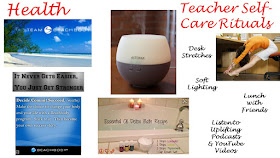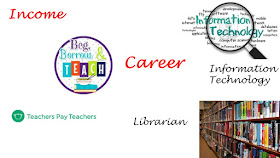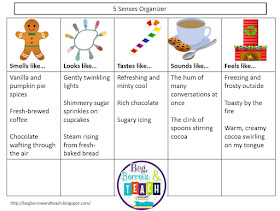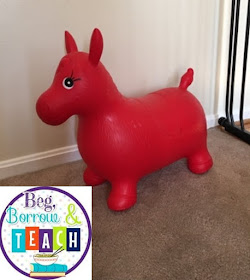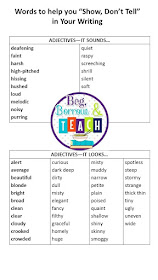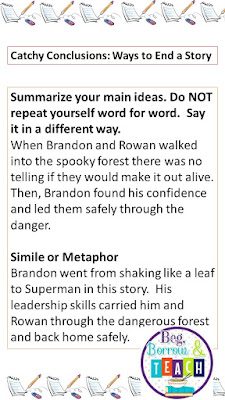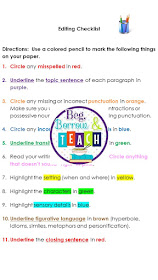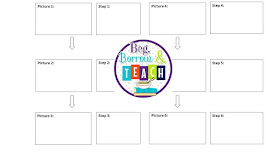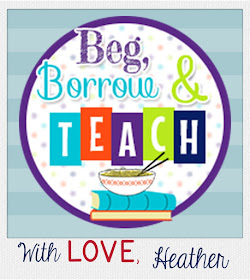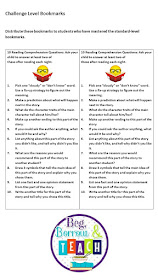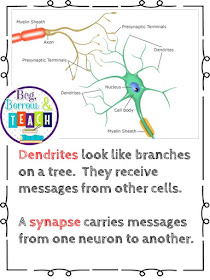Do you want to live your life with the same growth mindset you teach to your students? Then it's time to start thinking about what you want for yourself in the new year! Join me as I begin my vision board journey!
Even though it's not the new year yet, it is actually the best time to be thinking about what you want for yourself next year.
1. Think about the areas of your life and career that mean the most to you.
Don't just think about work. Be sure to add areas for personal growth and health, too.
Here are some of my top areas I will focus on next year:
Health
Teacher Self-Care
Income
Career
2. Choose whether you would like a tangible vision board or a digital one.
I chose digital for the ease of changing and adding to the pictures. I simply used PowerPoint, but many people prefer the tangibility of scrabooking their vision board.
3. Collect pictures from magazines or online that will help you visualize your areas of focus.
4. Look at your vision board several times a day.
I plan to look at it when I get up and before bed, at the very least.
That's it! So simple, but so effective. This will guide your thinking and actions each day.
How do you create goals for yourself for the next year? I'd love to hear about it!
Sunday, December 25, 2016
Sunday, December 18, 2016
5 Things to Do Before Winter Break to Reduce Stress Next Year
Would you like to be able to enjoy your winter break more? Would you like to return with less stress and a better sense of preparedness for those inevitable meetings that first week? If so, then read this post about my must-do list before I leave for winter break!
1. Make a to-do list for the week before you leave, but keep it short.
Sounds trite, I know, but having something tangible to remind me of what I have to get done before I leave motivates me and gives me a sense of satisfaction when I cross things off. The reason I say "keep it short" is because I can always add to it later if I get everything done. A long list makes me more nervous.
Here's my current list:
~Grade papers
~Put 2nd Quarter grades in computer
~Hang posters for next unit
2. Have at least a general idea of what you'll be teaching the week you return.
I know you are just trying to get through to winter break, but trust me, planning a little bit ahead will give you peace of mind during the break and lower your stress when you get back. Even if you can plan the first couple of days, that will help tremendously.
3. Check out an online planbook to streamline the planning process.
If you already have your plans written, awesome. If you don't, may I suggest an online planbook? I've been using planbook.com for about 4 years now, and I love it. It's so easy to change and add to from any device. If snow hits, I just bump my lessons forward. No more erasing and re-writing. No more lost sticky notes. Fun fact, I am NOT being paid to promote their website.
4. Get that copying done NOW.
Once you have a general plan of what you'll be teaching when you return, start making copies. You know the line will be long when you return. You know the copy machine will jam and waste time when 80 people are trying to use it at once. Why not get a little bit ahead of that stress? Even if you just copy a few key assignments, it will save you some headaches. I promise.
5. Practice some self-care EVERY day.
If you lower your stress before break, you will most likely return with a a better sense of calm after the break.
Here are some of my favorite self-care routines for teachers:
~Do stretches at your desk throughout the day
~Rub your favorite lotion or essential oil on your hands and inhale
~Listen to an audiobook on your way to school and home
~Write down at least one thing that went well each day and keep it to read when you need a reminder of how you are doing a great job and YOU MATTER!
~If you can, do a couple of laps around the hallways of your school at a brisk pace to get your blood flowing. FEEL-GOOD BONUS: Do this with a favorite teacher friend.
For days when all else fails, during your planning period:
~Shut the door, turn the overhead lights down, draw the shades, turn on soft lighting, play your favorite music or put an uplifting/funny YouTube video on in the background while you work. I swear this one works!
What do you do to make the beginning of the year start off smoothly? I'd love to hear about it!
1. Make a to-do list for the week before you leave, but keep it short.
Sounds trite, I know, but having something tangible to remind me of what I have to get done before I leave motivates me and gives me a sense of satisfaction when I cross things off. The reason I say "keep it short" is because I can always add to it later if I get everything done. A long list makes me more nervous.
Here's my current list:
~Grade papers
~Put 2nd Quarter grades in computer
~Hang posters for next unit
2. Have at least a general idea of what you'll be teaching the week you return.
I know you are just trying to get through to winter break, but trust me, planning a little bit ahead will give you peace of mind during the break and lower your stress when you get back. Even if you can plan the first couple of days, that will help tremendously.
3. Check out an online planbook to streamline the planning process.
If you already have your plans written, awesome. If you don't, may I suggest an online planbook? I've been using planbook.com for about 4 years now, and I love it. It's so easy to change and add to from any device. If snow hits, I just bump my lessons forward. No more erasing and re-writing. No more lost sticky notes. Fun fact, I am NOT being paid to promote their website.
4. Get that copying done NOW.
Once you have a general plan of what you'll be teaching when you return, start making copies. You know the line will be long when you return. You know the copy machine will jam and waste time when 80 people are trying to use it at once. Why not get a little bit ahead of that stress? Even if you just copy a few key assignments, it will save you some headaches. I promise.
5. Practice some self-care EVERY day.
If you lower your stress before break, you will most likely return with a a better sense of calm after the break.
Here are some of my favorite self-care routines for teachers:
~Do stretches at your desk throughout the day
~Rub your favorite lotion or essential oil on your hands and inhale
~Listen to an audiobook on your way to school and home
~Write down at least one thing that went well each day and keep it to read when you need a reminder of how you are doing a great job and YOU MATTER!
~If you can, do a couple of laps around the hallways of your school at a brisk pace to get your blood flowing. FEEL-GOOD BONUS: Do this with a favorite teacher friend.
For days when all else fails, during your planning period:
~Shut the door, turn the overhead lights down, draw the shades, turn on soft lighting, play your favorite music or put an uplifting/funny YouTube video on in the background while you work. I swear this one works!
What do you do to make the beginning of the year start off smoothly? I'd love to hear about it!
Sunday, December 11, 2016
Seasonal Sensory Writing: Winter Bakery
Now that the weather is a bit chillier and coffee shops everywhere are offering flavors only available this time of year, it's time to use those sensory experiences in your writing with my Winter Bakery: Sensory Writing for the Season!
Before reading, I hand out the a double-sided graphic organizer. The first side has my filled-in version of the "5 Senses Organizer" and the other side is blank. The filled-in version is below.
We talk about why I chose the words I did to fill in the organizer (descriptive and sensory). They then try to find words like these in the mentor texts as we read them aloud together and fill in their side of the organizer.
We also discuss their favorite place to eat. It can be everything from their own kitchen to Panera. I do try to steer them towards a place that offers an atmosphere unique to the season. For example, if their favorite place to eat is Burger King, they are not going to have as much to write about pertaining to the holidays. However, we work with what we get. Even Burger King offers some sensory experiences.
If you'd like to pick up a copy of my Winter Bakery: Sensory Writing for the Season, click here.
How do you bring the season's sensory experiences into your writing? I'd love to hear about it!
The first thing I like to do with students is to read some sensory-filled mentor texts with the students. We collect words that match each of the senses in our writing journals and I keep them on anchor charts as we go.
My Sensory Writing Packet includes several more mentor text suggestions, but these are two of my favorites.
My Sensory Writing Packet includes several more mentor text suggestions, but these are two of my favorites.
Before reading, I hand out the a double-sided graphic organizer. The first side has my filled-in version of the "5 Senses Organizer" and the other side is blank. The filled-in version is below.
We talk about why I chose the words I did to fill in the organizer (descriptive and sensory). They then try to find words like these in the mentor texts as we read them aloud together and fill in their side of the organizer.
We also discuss their favorite place to eat. It can be everything from their own kitchen to Panera. I do try to steer them towards a place that offers an atmosphere unique to the season. For example, if their favorite place to eat is Burger King, they are not going to have as much to write about pertaining to the holidays. However, we work with what we get. Even Burger King offers some sensory experiences.
If you'd like to pick up a copy of my Winter Bakery: Sensory Writing for the Season, click here.
How do you bring the season's sensory experiences into your writing? I'd love to hear about it!
Sunday, December 4, 2016
Indoor Gross-Motor Activities to Burn Off Energy
What do you do with all the energy children have on those days when you are stuck inside? You get them moving with gross motor activities! Read on to see some of our favorite activities to do on a rainy day.
This soccer ball works great on hard surfaces, but it works especially great on carpet.
Here is a "Kick the Cup" alphabet recognition game you could use with the soccer ball.
This Little Tikes Trampoline is awesome! My son will hold on to the bar and jump while watching TV. Another great activity to put some balls on the trampoline and see if he can bounce them off.
Here's a list of additional activities to do on the trampoline.
This hoppy animal is great for sitting and bouncing while watching TV or for having races to see how fast we can get to the kitchen.
This 6-inch parachute is just fun! There are so many games you can play with it.
These are parachute games "for toddlers", but I think any age would enjoy them with slight modifications.
One of our favorites is the Magic Moves Electronic Wand. It says an animal or thing and asks you to do some sort of movement to go with it. For example, "waddle like a penguin" or "grow like a flower". It plays music to encourage the movement for about 30 seconds. You can push "play" to get a new movement/song or "repeat" to do the previous one.
Do you have any go-to resources or activities to get kids moving in inclement weather? I'd love to hear about them!
Sunday, November 27, 2016
Editing and Revising Made Easy
Would you like to provide your students with an easy way to edit and revise their writing? How about a visual reminder of what good writing looks like? If so, then check out my Editing and Revising Made Easy Packet!
I like to print and laminate all the
pages. I hole-punch them and use binder
rings through the holes to hold all the pages together. Another
option is to put all the
pages in sheet protectors and use the rings to hold them together (see the picture below). I like to have one Editing-Revising
Packet for each student to keep at their desk for reference when they are
writing.
The Bold Beginnings piece of the packet is a natural
place to start. This is a sample of my larger Bold Beginnings and Catchy Conclusions packet.
After students have written a good, solid opening/hook, it's time to think about how to "Show, Don't Tell" with their writing. In other words, painting a mental picture of their writing topic. A great way to do this is with adjectives. I've included adjective lists for the senses: Sound, sight, taste, and touch.
After students have written a good, solid opening/hook, it's time to think about how to "Show, Don't Tell" with their writing. In other words, painting a mental picture of their writing topic. A great way to do this is with adjectives. I've included adjective lists for the senses: Sound, sight, taste, and touch.
After writing the middle of the piece,
it’s on to the catchy conclusion. I’ve
included examples for the following ways to conclude a piece of writing:
Summary, simile/metaphor, quotes.
Once the rough draft has been written,
students are asked to edit and revise their work. I ask my students to edit their own work and
at least one of their peer’s. For this
purpose, I’ve included a list of rules for Buddy Editing and an Editing
Checklist.
If you'd like to pick up a copy, click here.
Do you have any ways that make editing and revising easier for your students? I'd love to hear about them!
Sunday, November 20, 2016
Science Fair-Scientific Method: Resources to Save Your Sanity
Does the mere mention of the Science Fair raise your blood pressure? Do you wish there was a way to simplify the process while keeping it fun? Then this post is for you!
This is my first year as a middle school science teacher where my students have been required to participate in the science fair. Along the way, I've picked up some handy resources that I wanted to share with any of you who are also taking this journey into the world of the Scientific Method.
First of all, let me introduce a wonderful website: Science Buddies. This is a completely FREE website. No need to create an account, either.
If a student truly has no idea what topic/project they'd like to pursue:
They can click the "Find a Project Idea" button in the middle of the main page. This will have them take a short quiz about their interests and hobbies, from which the website creates an extensive list of projects that match the student's answers.
What if the student already has a topic that interests them?
Then simply type the topic in the search box at the top of the screen. The website will produce a list of projects involving your topic.
Easy, peasy!
The following are some criteria I use to help students narrow down their search. The project must:
Not be too expensive (no more than $50 without parent permission)
If it includes humans or animals, extra consent/permission forms are required
Be a real-world problem that can be solved (no demonstrations or "How-To" projects)
Not include substances or items that are against school policy (weapons, drugs, etc.)
Be something that can be done within the school year (about a 3-4 month period)
Be approved by a parent (with a signature)
The student has chosen a project. Now what?
They need to do research on the topic and find out what information already exists.
I have students find 3 sources: 1 print and 2 websites. This will be made easier if one of the websites is Sciencebuddies.
I then have them use this free bibliography/works cited generator website. They can copy and paste the results into a Word or Google Doc.
Once the sources are cited, I have students write a 4-6 sentence paragraph on what they learned while doing the research.
After the research, students begin the process of writing the rough draft of their report.
Graphic organizers are the best and easiest way I've found to start this process.
For primary students, this organizer will help them begin to collect data.
This foldable is a good graphic organizer for older students or introduction to the scientific method for younger students.
It includes:
~Directions on how to cut, fold, and glue the foldable.
~The 6 steps to the Scientific Method (Problem, Hypothesis, Experiment, Observation, Results, Conclusion).
~Brief explanations of each step to guide students in their thinking.
~Space for students to write their thinking for each of the steps.
For secondary students, this organizer includes more details and steps of the Scientific Method.
This organizer helps students prepare for writing a final report for either a traditional experiment or the science fair. It includes the following sections to be filled in by the student as they progress in the experiment:
~Problem
~Hypothesis
~Materials
~Variables
~Procedures
~Data Collection
~Results
~Conclusion
After the experiment is done, students type the report from the graphic organizer in a formal way and create the display board. This year, I'm having students use Google Slides instead of the traditional display boards. This is less cost-prohibitive and it can be typed, saved, and shared much more easily through Google Drive.
Since this is my first year doing the Science Fair with middle-schoolers, I need all the help I can get! If you'd be willing to share some of your favorite resources for the Scientific Method/Science Fair, I'd be so grateful!
This is my first year as a middle school science teacher where my students have been required to participate in the science fair. Along the way, I've picked up some handy resources that I wanted to share with any of you who are also taking this journey into the world of the Scientific Method.
First of all, let me introduce a wonderful website: Science Buddies. This is a completely FREE website. No need to create an account, either.
If a student truly has no idea what topic/project they'd like to pursue:
They can click the "Find a Project Idea" button in the middle of the main page. This will have them take a short quiz about their interests and hobbies, from which the website creates an extensive list of projects that match the student's answers.
What if the student already has a topic that interests them?
Then simply type the topic in the search box at the top of the screen. The website will produce a list of projects involving your topic.
Easy, peasy!
The following are some criteria I use to help students narrow down their search. The project must:
Not be too expensive (no more than $50 without parent permission)
If it includes humans or animals, extra consent/permission forms are required
Be a real-world problem that can be solved (no demonstrations or "How-To" projects)
Not include substances or items that are against school policy (weapons, drugs, etc.)
Be something that can be done within the school year (about a 3-4 month period)
Be approved by a parent (with a signature)
The student has chosen a project. Now what?
They need to do research on the topic and find out what information already exists.
I have students find 3 sources: 1 print and 2 websites. This will be made easier if one of the websites is Sciencebuddies.
I then have them use this free bibliography/works cited generator website. They can copy and paste the results into a Word or Google Doc.
Once the sources are cited, I have students write a 4-6 sentence paragraph on what they learned while doing the research.
After the research, students begin the process of writing the rough draft of their report.
Graphic organizers are the best and easiest way I've found to start this process.
For primary students, this organizer will help them begin to collect data.
This foldable is a good graphic organizer for older students or introduction to the scientific method for younger students.
It includes:
~Directions on how to cut, fold, and glue the foldable.
~The 6 steps to the Scientific Method (Problem, Hypothesis, Experiment, Observation, Results, Conclusion).
~Brief explanations of each step to guide students in their thinking.
~Space for students to write their thinking for each of the steps.
For secondary students, this organizer includes more details and steps of the Scientific Method.
This organizer helps students prepare for writing a final report for either a traditional experiment or the science fair. It includes the following sections to be filled in by the student as they progress in the experiment:
~Problem
~Hypothesis
~Materials
~Variables
~Procedures
~Data Collection
~Results
~Conclusion
After the experiment is done, students type the report from the graphic organizer in a formal way and create the display board. This year, I'm having students use Google Slides instead of the traditional display boards. This is less cost-prohibitive and it can be typed, saved, and shared much more easily through Google Drive.
Since this is my first year doing the Science Fair with middle-schoolers, I need all the help I can get! If you'd be willing to share some of your favorite resources for the Scientific Method/Science Fair, I'd be so grateful!
Sunday, November 13, 2016
Thanksgiving Personification Writing
Do you have a little time before Thanksgiving break, but don't want to start a lengthy writing assignment? Would you like a fun way to introduce or review figurative language (personification) and writing step-by-step narratives? Then read this post about my Thanksgiving Personification Writing!
We start by reading some of our favorite mentor texts to help us collect good descriptive words about Thanksgiving/Fall foods.
Then I show them my example organizer that is already filled in.
I then provide them with a blank organizer of their own.
I work with small groups to fill this out and begin writing their paragraphs.
I give the "Wanted Poster" activity to early finishers.
It's a fun little writing activity that usually takes about a week.
You can pick up a copy by clicking here.
What do you do with your writing block before Thanksgiving? I'd love to hear about it!
We start by reading some of our favorite mentor texts to help us collect good descriptive words about Thanksgiving/Fall foods.
Then I show them my example organizer that is already filled in.
I then provide them with a blank organizer of their own.
I work with small groups to fill this out and begin writing their paragraphs.
I give the "Wanted Poster" activity to early finishers.
It's a fun little writing activity that usually takes about a week.
You can pick up a copy by clicking here.
What do you do with your writing block before Thanksgiving? I'd love to hear about it!
Sunday, November 6, 2016
Veterans Day Activities FREEBIE
Veterans Day is November 11th, 2021. One of my favorite ways to honor the members of our military is in Language Arts. Read on to check out my Veterans Day Unit Lessons!
The first thing we do is read the following mentor texts. Students collect words and phrases that help them describe what Veterans Day is and why it's important to them.
Check out the full post on the Virginia is for Teachers Blog!
The first thing we do is read the following mentor texts. Students collect words and phrases that help them describe what Veterans Day is and why it's important to them.
Check out the full post on the Virginia is for Teachers Blog!
Sunday, October 30, 2016
Reading Comprehension Bookmarks: An Alternative to Reading Logs
Would you like:
1. A quick and effective way to involve parents in nightly reading?
2. An alternative to a reading log that still holds students accountable for what they read?
3. A supplement to your current reading log that keeps things fresh?
2. An alternative to a reading log that still holds students accountable for what they read?
3. A supplement to your current reading log that keeps things fresh?
I came up with this idea when parents were asking me for an alternative way to assess their child's nightly reading comprehension, rather than just signing the Reading Log. I sat down and thought about the core questions that would demonstrate an overall understanding of any text. This is how my Reading Comprehension Bookmarks were born.
Using the bookmarks instead of a Reading Log:
Using the bookmarks instead of a Reading Log:
I have parents choose 2 of the questions on the bookmark to ask their child each night after reading, and write the number of the questions asked in their child's agenda. I ask parents to choose different questions each night, so different levels and concepts of comprehension are tested.
Using the bookmarks with a Reading Log:
If
the reader truly understood what they
read, they should be able to answer all of them correctly. If the reader is unable to answer, they
should go back and reread that portion of the text.If
the reader truly understood what they
read, they should be able to answer all of them correctly. If the reader is unable to answer, they
should go back and reread that portion of the text.
Using the bookmarks with a Reading Log:
I've used them in conjunction with a Reading Log. In this case, I still have parents sign the reading log and there is a section to indicate which numbers of the questions from the bookmark were asked that night.
I've found both ways to be effective, depending on the needs of the student and parent. This is a great way to differentiate reading comprehension homework.
If you'd like to pick up a copy, click here.
If you'd like to pick up a copy, click here.
Sunday, October 23, 2016
Growth Mindset Poster Scavenger Hunt
Would you like to inspire your students to have a Growth Mindset? Would you like to incorporate movement and collaborative learning into your Growth Mindset lesson? If so, then this post is for you!
We've been using Mindsets in the Classroom: Building a Culture of Success and Student Achievement in Schools by Mary Cay Ricci in our school and county. My school is also focusing on getting the students up and moving while learning. Then it dawned on me: I should combine the two and do a gallery walk/scavenger hunt!
The Growth Mindset Poster Gallery Walk / Scavenger Hunt starts with 10 growth mindset quotes.
Students walk around the room and answer questions about the posters. There is an answer key included to make the activity self-checking or for aid in use as a formative/summative assessment.
The second poster scavenger hunt focuses on the neuroscience behind having a growth mindset.
Some of the posters focus on how to strengthen the brain with food.
Other posters focus on the nerve and brain cells.
The Growth Mindset Poster Gallery Walk / Scavenger Hunt starts with 10 growth mindset quotes.
Students walk around the room and answer questions about the posters. There is an answer key included to make the activity self-checking or for aid in use as a formative/summative assessment.
The second poster scavenger hunt focuses on the neuroscience behind having a growth mindset.
Some of the posters focus on how to strengthen the brain with food.
Other posters focus on the nerve and brain cells.
Students are again asked to take a gallery walk and answer questions about the posters.
The entire packet includes:
~10 growth mindset poster quotes, some by famous people
~A scavenger hunt student sheet and answer key for the quotes
~10 posters on how the brain works and how to strengthen it
~A scavenger hunt student sheet and answer key for the brain section of the scavenger hunt
If you'd like to pick up a copy, click here.
Do you have any low-prep, fun activities to teach or reinforce growth mindset? I'd love to hear about them!
The entire packet includes:
~10 growth mindset poster quotes, some by famous people
~A scavenger hunt student sheet and answer key for the quotes
~10 posters on how the brain works and how to strengthen it
~A scavenger hunt student sheet and answer key for the brain section of the scavenger hunt
If you'd like to pick up a copy, click here.
Do you have any low-prep, fun activities to teach or reinforce growth mindset? I'd love to hear about them!
